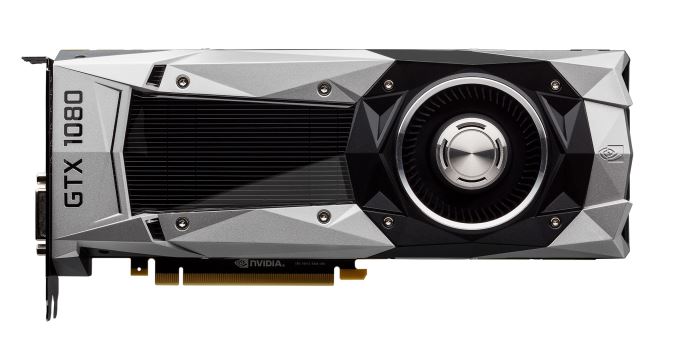The NVIDIA GeForce GTX 1080 Preview: A Look at What's to Come
by Ryan Smith on May 17, 2016 9:00 AM ESTFirst Thoughts
Wrapping up our preview of the GeForce GTX 1080, I think it’s safe to say that NVIDIA intends to start off the 16nm/14nm generation with a bang. As the first high-end card of this generation the GTX 1080 sets new marks for overall performance and for power efficiency, thanks to the combination of TSMC’s 16nm FinFET process and NVIDIA’s Pascal architecture. Translating this into numbers, at 4K we’re looking at 30% performance gain versus the GTX 980 Ti and a 70% performance gain over the GTX 980, amounting to a very significant jump in efficiency and performance over the Maxwell generation.
Looking at the bigger picture, as the first vendor to launch their 16nm/14nm flagship card, NVIDIA will get to enjoy the first mover’s advantage both with respect to setting performance expectations and with pricing. The GeForce GTX 1080 will keep the performance crown solidly in NVIDIA’s hands, and with it control of the high-end video card market for some time to come. NVIDIA’s loyal opposition, AMD’s Radeon Technologies Group, has strongly hinted that they’re not going to be releasing comparable high-performance video cards in the near future. Rather the company is looking to make a run at the much larger mainstream market for desktops and laptops with their Polaris architecture, something that GP104 isn’t meant to address.
The lack of competition at the high-end means that for the time being NVIDIA can price the GTX 1080 at what the market will bear, and this is more or less what we’re looking at for NVIDIA’s new card. While the formal MSRP on the GTX 1080 is $599 – $50 over what the GTX 980 launched at – that price is the starting price for custom cards from NVIDIA’s partners. The reference card as we’ve previewed it today – what NVIDIA is calling the Founders Edition card – carries a $100 premium over that, pushing it to $699.
| GeForce GTX 1080 Configurations | ||||
| Base | Founders Edition | |||
| Core Clock | 1607MHz | 1607MHz | ||
| Boost Clock | 1733MHz | 1733MHz | ||
| Memory Clock | 10Gbps GDDR5X | 10Gbps GDDR5X | ||
| Cooler | Manufacturer Custom (Typical: 2 or 3 Fan Open Air) |
NVIDIA Reference (Blower w/Vapor Chamber) |
||
| Availability Date | June 2016? | 05/27/2016 | ||
| Price | Starting at $599 | $699 | ||
While the differences between the reference and custom cards will be a longer subject for our full review, the more immediate ramification is going to be that only the Founders Edition cards are guaranteed to be available at launch. NVIDIA can’t speak definitively for their board partners, but at this point I am not seriously expecting custom cards until June. And this means that if you want one of the first GTX 1080s, then you’re going to have to pay $699 for the Founders Edition card. Which is not to say that it’s a bad card – far from it, it’s probably NVIDIA’s finest reference card to date – however it pushes the card’s price north of 980 Ti territory, some $150 higher than where the GTX 980 launched in 2014. For those who can afford such a card they will not be disappointed, but it’s definitely less affordable than past NVIDIA x80 cards.
Anyhow, we’ll be back later this week with our full review of the GeForce GTX 1080, so be sure to stay tuned.
| Spring 2016 GPU Pricing Comparison | |||||
| AMD | Price | NVIDIA | |||
| $699 | GeForce GTX 1080 FE | ||||
| Radeon R9 Fury X | $609 | ||||
| $589 | GeForce GTX 980 Ti | ||||
| $429 | GeForce GTX 980 | ||||
| Radeon R9 390X | $399 | ||||
| Radeon R9 390 | $289 | GeForce GTX 970 | |||











262 Comments
View All Comments
Ryan Smith - Tuesday, May 17, 2016 - link
It's an all flagship lineup. 290X was AMD's flagship from 2013 to 2015. 390X was never their flagship.Eden-K121D - Wednesday, May 18, 2016 - link
How Come?just4U - Wednesday, May 18, 2016 - link
Fury came along..Guspaz - Tuesday, May 17, 2016 - link
I'm hoping the full article compares it to cards outside the same class, like the 970. It's hard to judge upgrade effectiveness if cards are only ever compared against other top-end cards.Beararam - Tuesday, May 17, 2016 - link
"I also wanted to quickly throw in a 1080p chart, both for the interest of comparing the GTX 1080 to the first-generation 28nm cards, and for gamers who are playing on high refresh rate 1080p monitors."THANK YOU, high refresh seems to be swept under the carpet for 3.8k displays. The old 780 I have is trying it's best to remain relevant, but can't seem to make a 144hz panel worth it's while.
brucek2 - Tuesday, May 17, 2016 - link
+1Lonyo - Tuesday, May 17, 2016 - link
Finally time to consider upgrading once the AMD cards are out to see which is best value and prices have stabilised.wishgranter - Tuesday, May 17, 2016 - link
Hi Ryanplease test it HARD in the COMPUTE part, as gaming benchmarks are everywhere now.
for us using it in COMPUTE is more interesting... :D
dragonsqrrl - Tuesday, May 17, 2016 - link
Yep, haven't seen any compute results yet in other reviews. Likely unparalleled single and half precision performance, and mediocre double precision.lefty2 - Tuesday, May 17, 2016 - link
Why did they compare DX11 and DX12 results in Hitman, but not ashes of singularity? Anyone else find that odd?